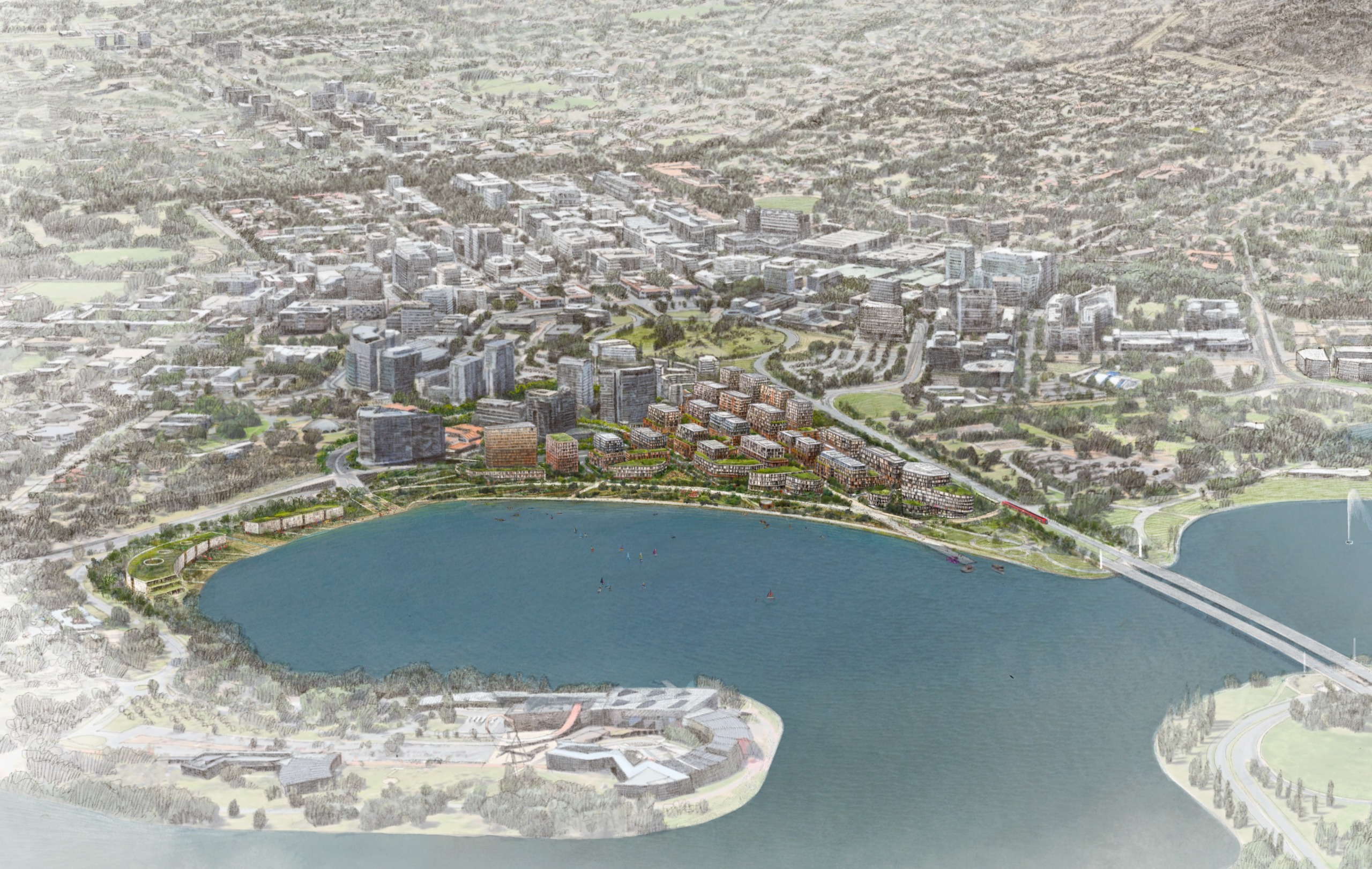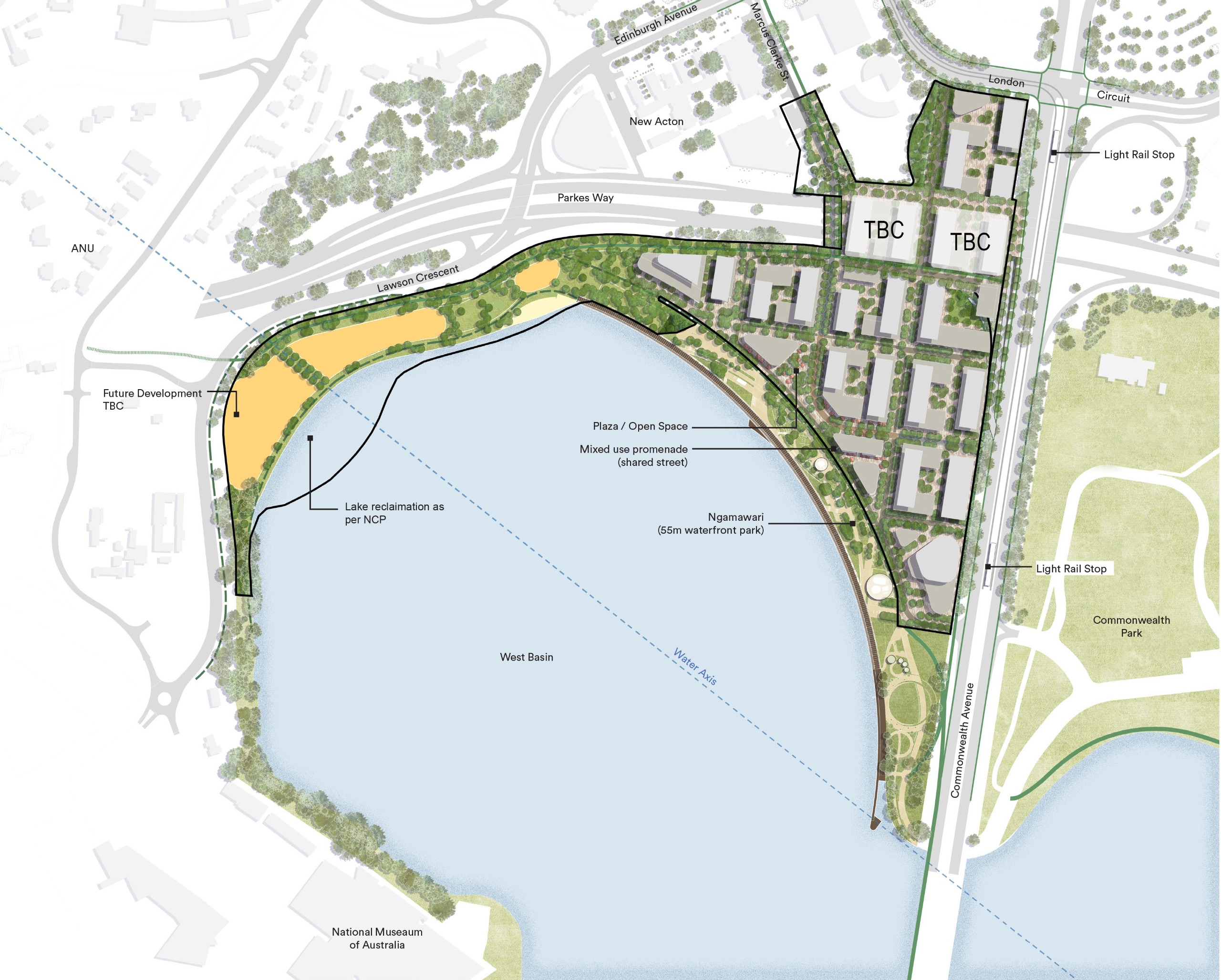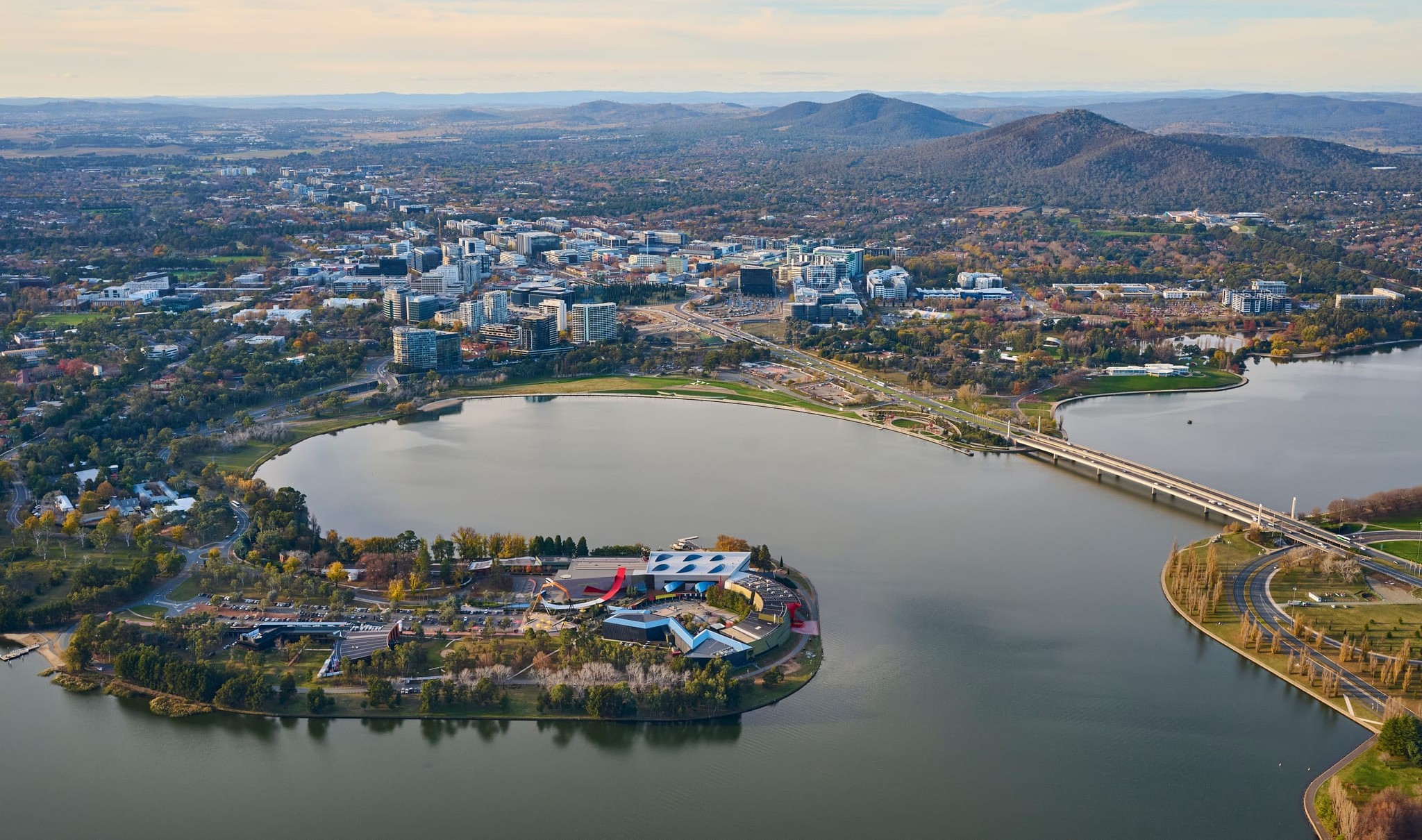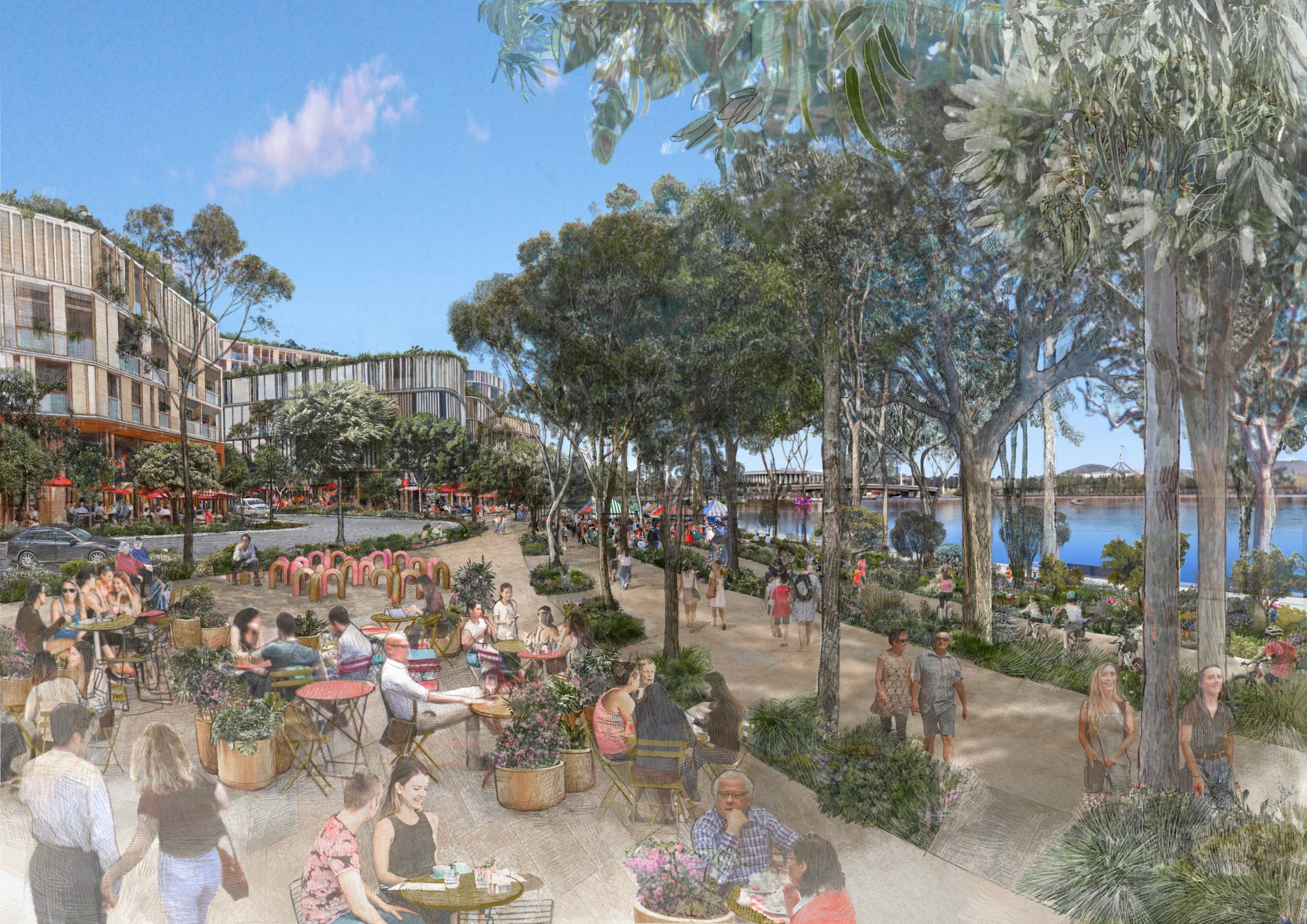View the survey
Tell us your thoughts on the proposed design principles for the neighbourhood by completing the survey.
The City Renewal Authority is committed to delivering a world-class waterfront destination and neighbourhood at Acton – a lively, mixed-use precinct that extends the City Centre to the waterfront and celebrates Canberra’s national capital character.
This consultation builds on design engagement undertaken in 2022-23 which has helped us shape the current design approach and draft principles. Community feedback gathered through this round of consultation will further refine those principles and guide the planning pathway needed to bring the Acton Waterfront vision to life.
The public consultation ran for six weeks from 4 November - 17 December, ensuring Acton Waterfront continues to be shaped by and for the people of Canberra.
Important note on images: Any images or concepts shown here of the new Acton Waterfront are indicative only and should not be considered the final design. They are illustrative designs intended to show how the design principles outlined below can be achieved.

Aerial artists impression of future Acton Waterfront. A contemporary design solution which builds on the planning controls from the National Capital Plan West Basin Precinct Code, to enhance sustainability and design principles. Building heights are designed to create a lively precinct - lower near parks and open spaces and taller near transport routes and future light rail stops.
The Acton Waterfront neighbourhood is a unique and exciting project for Canberra. This area will become a lively and engaging destination.
Located adjacent to both Parkes Way and Commonwealth Avenue, the overall goal is to build a connected, sustainable, and people-focused precinct that reflects Canberra's lifestyle and values. The project aims to bring everyday life to the waterfront by:
View how you could have your say on the proposed design principles for the neighbourhood.
We are seeking feedback on our proposed design principles and how well they achieve the vision for a lively, people-centred neighbourhood.
To enable a more liveable neighbourhood, we want to understand from you what makes a great waterside neighbourhood and how Acton Waterfront can best reflect Canberra’s lifestyle and identity.
The design of this liveable neighbourhood starts with strong design principles that guide how the buildings, streets, and public spaces work together.
These principles focus on:

Indicative waterfront layout (Including promenade, recreational spaces, and buildings)
The Acton Waterfront project aims to deliver a high-quality, lively and people-focussed destination. The National Capital Plan (NCP), developed nearly 20 years ago, provides a strong foundation for this vision. We have the opportunity, however, to consider how the planning framework can evolve to support even better design and community outcomes.
To achieve an active community, the ACT Planning strategy suggests areas in close proximity to a local city centre should hit a density of approximately 330 people per hectare. The density currently achievable, however, is around 220 people per hectare. Housing options under the current plan are also less diverse and, some design outcomes under the current rules can lead to challenges like overshadowing and reduced solar access in public areas and apartments. It is also harder to strengthen the connection between the waterfront and the City Centre.
The City Renewal Authority is proposing a way forward that will create a place people will love from day one - a place that is lively, inclusive, and unmistakably Canberra. By making strategic changes, the project can:

Streetscape view from main vehicular bridge crossing Parkes Way, looking towards Lake Burley Griffin
To achieve this ambitious vision, an update to the NCP may be needed, unlocking the required density, diversity, and design flexibility to create a neighbourhood that is nationally recognised and globally admired, sustainable and comfortable for all, connecting to with infrastructure like future light rail stops.


The current Acton Waterfront, soon to be transformed into a lively, connected neighbourhood. And an optimised design that enhances the current planning framework to ensure outcomes exceed national design and sustainability standards.
The image on the left shows the current Acton Waterfront, soon the be transformed into a lively, connected neighbourhood linking the City Centre to Lake Burley Griffin. The artist's impression on the right shows the proposed design, where revisions to the planning rules ensure public spaces stay sunny, wind is managed, and views to the lake are protected. This type of design helps us create a more active and sustainable community.
Your feedback is absolutely essential and will help shape the project's next steps. Community input will help refine the final design before an NCP amendment is submitted for consideration, if required. The community will also have a further opportunity to provide design feedback through that process.
We invited you to consider:

Artist's impression of Acton Waterfront - a welcoming public space that brings everyday life to the lake
You could get involved in several ways:
Complete the survey
Tell us your thoughts on the proposed design principles for the neighbourhood by completing the survey.
Community Panel
The City Renewal Authority formed a community panel to discuss design principles for the project. We received a strong response from the community, and the Panel met in-person on 2 December, 10am – 2pm.
Stakeholder workshops
The City Renewal Authority hosted two stakeholder workshops to seek feedback on the design principles. The workshops took place on 27 November and 1 December.
Tell us your thoughts on the proposed design principles for the neighbourhood by completing the survey.
The City Renewal Authority is currently asking for expressions of interest for a community panel to provide comment on the design principles.
Registrations Closed
27 November 2025
10.00am - 11.30am
Salthouse Community Centre
Henty Street, Braddon ACT 2612
Registrations Closed
1 December 2025
5.00pm - 6.30pm
Online (A link to the online meeting will be made available following registration)
Registrations Closed

We acknowledge the Ngunnawal people as traditional custodians of the ACT and recognise any other people or families with connection to the lands of the ACT and region. We acknowledge and respect their continuing culture and the contribution they make to the life of this city and this region.
This site is owned and operated by the ACT Government using software licensed from Social Pinpoint. For details on how the ACT Government collects and protects your personal information, refer to their Privacy Policy below. For details of how Social Pinpoint may access personal information, please refer to Social Pinpoint’s Privacy Policy.
The online 'YourSay' service is provided using a digital platform operated by the Chief Minister, Treasury and Economic Development Directorate (CMTEDD).
The ACT Government respects the rights and privacy of all individuals and is committed to complying with the Information Privacy Act 2014 and the Territory Privacy Principles and protecting the personal information we hold.
This Privacy Policy describes how the ACT Government collects and uses your personal information collected through the ‘YourSay’ website. Defined terms appear in bold and definitions appear at the end of the Statement.
CMTEDD (via Social Pinpoint which is contracted service provider of CMTEDD) collects your personal information as part of providing the Territory’s online community engagement services, informing you about these services, complying with contractual and other legal obligations, responding to your enquiries and administering its community engagement technology.
CMTEDD may use your personal information for these purposes, any other purpose listed on a collection statement at the point of collection, or in any other way made clear at the time of collecting the personal information. In cases where feedback is received about an engagement opportunity that is subject to another Territory agency's Terms and Conditions, or arrangements for handling personal information, your feedback may be provided to the agency concerned.
In your feedback to the ACT Government, you should not provide personal information, including personal health information (for example, any information (medical or otherwise) about a person’s health, mental status, treatments received etc) about any other person (a third person).
User feedback
We collect the comments, votes, posts and selections you contribute when interacting with the feedback mechanisms provided through 'YourSay', which include:
This information is analysed and interpreted by CMTEDD staff, staff of other ACT Government agencies and in some circumstances, third party contractors who have been engaged to assist in the analysis of the data collected, to inform the creation of better projects, plans and policies.
Can you remain anonymous or withhold personal information?
Yes. You can access and participate in select ‘YourSay’ engagements anonymously, without disclosing any personal information. Some identified studies may require you to register and establish an account in order to participate. Users may choose to adopt a pseudonym for these studies.
Registered Users
When you register for a ‘YourSay’ account or sign-in to your existing account, the information we may collect includes:
For engagements where you do not register for a ‘YourSay’ account, we may seek to collect from you:
Demographic details are requested in order to help us determine the degree to which views of participants are representative of a diverse cross-section of the community.
By providing an email address you help us protect the integrity of the discussion from individuals and groups who may attempt to unduly influence the outcomes of the consultation process anonymously. For example, we check the database to ensure each user has a single email account on the site. We also frequently review the site for trolls and spammers.
If you are registered and signed-in to your user account, the contributions and feedback you provide may be linked with your username and any demographic details you have recorded in your account.
Email notifications
If you subscribe to receive notifications about upcoming consultations and other engagement activities , the email address you provide will be used by CMTEDD to send you information and updates about new opportunities to have your say. You can unsubscribe from these updates notifications at any time.
If you subscribe to receive updates about a specific engagement project, for example by using the ‘Follow’ function, the email address you provide will be used to send you information and updates about that engagement. You can unsubscribe from these notifications at any time.
Cookies
Cookies are used on our site, but they do not collect any personal information. For the most part they are sessional and just contain system-generated values to identify the user's session for statistical and system administration purposes only.
For more information on Cookies and Google Analytics, please refer to the CMTEDD Privacy Policy.
Site visit data
The site’s web-server automatically collects the following de-identified data for statistical and system administration purposes only:
To the extent that this data could make you identifiable, CMTEDD and Social Pinpoint will not attempt to identify individuals from the records the server automatically generates unless necessary to investigate a breach of law or regulation.
When you sign up for and use the ‘YourSay’ service you provide two types of information:
Publicly available information
Publicly available information is limited to your username and any comments you leave under that username in the forums or other feedback tools published to ‘YourSay’.
You can use your first name or an anonymous username if you do not want your full name attached to forum and guestbook comments, stories or questions.
Feedback (including overall results of polls and surveys, and in some instances, quotes from forums and surveys) may be published in publicly available reports at the end of the consultation period.
Please note that the ACT Government is subject to the Freedom of Information Act 2016. The Freedom of Information Act 2016 provides a general right of access to government information. This includes documents created by the government, documents held by contracted service providers relating to the performance of government contracts and documents supplied to government by external organisations or individuals.
Information available to CMTEDD and Social Pinpoint (and which CMTEDD may disclose to other entities as set out in this privacy notice) includes:
Information available to third party contractors may include but is not limited to:
CMTEDD will take all reasonable measures to prevent unauthorised access to, or disclosure of, your personal information.
Organisations to which personal information is disclosed include other ACT Government directorates, the ACT Government’s contracted Service Providers, such as Social Pinpoint and their subcontractors or agents who may be based in Australia or overseas (namely in the Philippines), who perform various services for and on behalf of the ACT Government. These contractors have agreed to be bound by the provisions of the Information Privacy Act 2014.
We will also take all necessary measures to ensure that your personal information is not disclosed to other individuals, institutions and authorities except in accordance with the Information Privacy Act 2014, such as if required or authorised by law or explicitly permitted by you. Some examples of when information may be provided to another person without your consent include in the event of an investigation into suspected unlawful or improper activity or when a law enforcement agency or government agency may exercise its legal authority to inspect the web server's records (e.g. in relation to hacking or abusive messages).
You may seek corrections to your personal information that CMTEDD has collected if you believe it is inaccurate, out-of–date, incomplete, irrelevant or misleading. CMTEDD is required to take reasonable steps to correct personal information to ensure that, having regard to the purpose for which it is held, the information is not inaccurate, out-of–date, incomplete, irrelevant or misleading.
You may also seek access to your personal information that CMTEDD holds.
More information about seeking access to, and correction of, your personal information held by CMTEDD can be found in the CMTEDD Information Privacy Policy.
The ‘YourSay’ Privacy Statement does not apply to third party websites or digital services which may be linked to from content published to 'YourSay'. We recommend you read the privacy statement of the relevant service when you access these sites.
Third Party Providers
We sometimes use third party providers for some web-based services, with information stored in the United States and Europe. These include Campaign Monitor and Mail Chimp for email subscriptions, Survey Monkey and Typeform for online surveys, Social Pinpoint for interactive maps, Viostream for live streaming question and answers, MindHive for running a collaborative forum and EventBrite for registration at events. Please follow the hyperlinks for details on their privacy policies.
Campaign Monitor Privacy
CMTEDD uses Campaign Monitor to provide electronic newsletters to subscribers.
In distributing newsletters, CMTEDD, via Campaign Monitor, will collect personal information from you, including email addresses you have provided to CMTEDD for the purpose of receiving electronic newsletters, all information relating to those email addresses, and in some cases your name. Campaign Monitor also uses cookies, web beacons and Flash player codes to collect information for use by CMTEDD about:
CMTEDD holds the Campaign Monitor account and personal information collected through that account can be accessed by other agencies of the ACT Government for the purposes of sending electronic newsletters.
For additional detail about the information Campaign Monitor will collect, please refer to Campaign Monitor’s Privacy Policy and Campaign Monitor’s Terms of Use.
Campaign Monitor will use the information collected from you for the purpose of providing the online service which enables CMTEDD and other agencies of the ACT Government to create, send and manage electronic newsletters. Campaign Monitor will also use this information to measure the performance of CMTEDD and other ACT Government email campaigns.
Campaign Monitor may transfer this information to its contractors or other third parties who process the information on Campaign Monitor’s behalf, or where otherwise required to do so by law.
Campaign Monitor is based in the United States of America (USA) and is subject to the laws of the USA. Your information (including your IP address) will be transmitted to and stored by Campaign Monitor on servers located outside Australia.
You can unsubscribe from the 'YourSay' electronic newsletter at any time by selecting the 'unsubscribe’ option in every email sent to you by Campaign Monitor.
More information about how CMTEDD manages the personal information it collects can be found at https://www.act.gov.au/directorates-and-agencies/chief-minister-treasury-and-economic-development-directorate/cmtedd-privacy.
If you have any questions relating to the use of your personal data please contact askus@yoursay.act.gov.au.
Whole of Government Engagement Customer Relationship Management System
If you provide your personal information during an engagement, it may be included in a Whole of Government Customer Relationship Management System (CRM), together with the feedback or views you provide, and handled in accordance with Schedule 1 of the Information Privacy Act 2014, and the Territory Privacy Principles (TPPs).
The CRM system has been designed to provide directorates’ employees or authorised contractors with a place to store information about engagements with stakeholders and access information about engagements with stakeholders undertaken by other employees or authorised contractors. Information in the CRM may be used to inform subsequent engagements with the same or similar stakeholders. The use of the database is intended to strengthen coordination between ACT Public Sector agencies and reduce duplication of effort and stakeholder fatigue, by sharing information about engagement activities across government.
More detailed information about how your personal information is handled is available in the CRM Privacy Notice available at https://www.act.gov.au/privacy. Further information about directorates’ privacy policies and where to locate them can be found in the CRM Privacy Notice.
If you have any comment in relation to any aspect of the collection, use, security of, or access to your personal information please contact us via:
Mail:
Privacy Contact Officer
Chief Minister, Treasury and Economic Development Directorate
GPO Box 158
CANBERRA ACT 2601
Email: CMTEDDCorporate@act.gov.au
Or you can contact the Privacy Contact Officer by phone: +61 2 6207 5883 or +61 2 6207 8175
Personal information
Information or an opinion about an identified individual, or an individual who is reasonably identifiable:
but does not include personal health information about the individual.
Personal health information
Personal health information means any personal information, whether or not recorded in a health record:
(a) relating to the health, an illness or a disability of the consumer; or
(b) collected by a health service provider in relation to the health, an illness or a disability of the consumer.
For information about the broader collection and use of personal information by the ACT Government, or who to contact for more information, please refer to the CMTEDD Privacy Policy.
The following Terms of Use govern the use of ‘Your Say’ (“the site”). The platform is owned and operated by, Social Pinpoint Pty Ltd, on behalf of the Chief Minister, Treasury and Economic Development Directorate (CMTEDD).
By accessing and using this site, you are choosing to accept and comply with the Terms presented throughout this agreement as well as the Privacy Policy and Moderation Policy. These Terms apply to all visitors and users of this site. Linked sites, affiliated services or third party content or software have their own Terms that you must comply with. If you disagree with any of the Terms presented in this agreement, you may discontinue using the site immediately.
If you are under 18 years old, please ensure that your parent or guardian understands and accepts these Terms and Conditions (including the Privacy Policy and Moderation Policy).
What are the conditions with a user’s account?
While using the site, you must not violate any applicable laws and regulations. It is our duty to protect the confidentiality of content you provide on our site in accordance with our Privacy Policy. If you create an account with us, you must always provide us with accurate information. Failure to provide accurate information violates the Terms, which may result in immediate termination of your account on our service. Unauthorised use of your account must be immediately reported to Social Pinpoint. In some cases, we or our agents may require access to your user accounts to respond to technical issues.
If you want to terminate your own account, please send an email to info@socialpinpoint.com.
We are not responsible for the content on the site that has been provided by the users of the site. Any content posted by you is subject to the rules of our Moderation Policy. Your contribution to the site may be edited, removed or not published if we consider it inappropriate (refer to Moderation Policy). Contributors should also be aware that their posts may remain online indefinitely. Where practical, you may choose not to identify yourself, deal with us on an anonymous basis or use a pseudonym.
What’s required of users?
You must understand and agree that, without limitation:
Governing Law
These Terms shall be governed in accordance with the laws of the Australian Capital Territory.
What content does the ACT Government own?
Your Say website contains the copyrighted material, trademarks, patents, trade secrets and other proprietary information (“Intellectual Property”) of Social Pinpoint and its suppliers and licensors. ACT Government owns and retains all proprietary rights in the intellectual property. All intellectual property in the content of this site including without limitation to text, software, source code, pages, documents and online graphics, photographs, sounds, audio, video and other interactive features are owned by or licensed to us.
Any original content that you submit or post on our site may be made available to the public and allows users to share your content (with the end user acknowledging your contribution) under the Creative Commons Attribution-ShareAlike 4.0 Australian License.
Except for Intellectual Property which is in the public domain or for which you have been given written permission, you may not copy, alter, transmit, sell, or distribute any of the Intellectual Property.
We are not responsible for your communications or dealings, including payment and delivery of goods or services, with a third party found via our website. Any loss or damage incurred from those communications or dealings are solely between the user and the third party.
Disclaimer and Warranties
Users must agree that your use of the site is at your own risk. We make no warranty that the site will meet your requirements or be uninterrupted or error-free. Any material that the user downloads through the site is done at their own risk and users are responsible for any damages to their computer system or loss of data.
What happens if these Terms change?
We reserve the right, at our sole discretion, to modify or replace these Terms at any time without notice. The most recent version of the Terms can be seen on this page. By continuing to access or use our site after those revisions become effective, you agree and will comply to the revised terms. If you do not agree to the revised terms, please discontinue using our site.
Contact Us
If you have any questions about these Terms, please contact us at askus@yoursay.act.gov.au
Enter your email address below. We will send you instructions to reset your password.
Back to Log in
Join our online community
Creating an account helps us better understand your needs and the needs of the community.
Already have an account? Log in now
Thank you, your account has been created.
Completing the questions below helps us better understand the diverse range of people who contribute their ideas. The questions are optional.
You’re using an outdated browser.
Some features of this website may not work correctly. To get a better experience we strongly recommend you download a new browser for free: